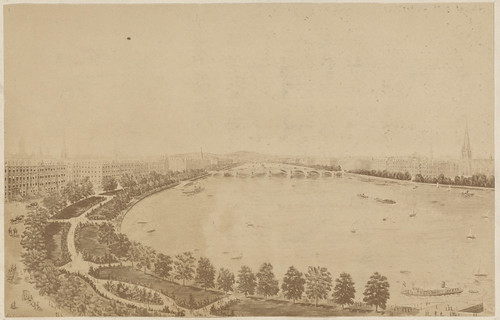Where's the LIKE button?!
However, I still see highways needing to be viable for local/small region distribution. So tightening the ramps isn't so good for commercial vehicles. I think every highway should have tolls, where it's a mere couple dollars for commercial vehicles, but sky high tolls for all others.
How about this. Change the rules for interstates at the national level so the states can toll any of them (not just grandfathered turnpikes). Toll all the expressways that cross state lines: I-91 Longmeadow & Bernardston, I-95 Attleboro & Salisbury, I-93 Methuen, I-295 North Attleboro, I-395 Webster, I-195 Seekonk, US 3 Tyngsboro, MA 146 Uxbridge, MA 24 Fall River. Pike already has 'em, and I-84 has de facto state-line tolls because of the Pike. These would be high-speed speed-limit tolls that don't even require a slowdown except for maybe 2 cash booths stuck in as a catch-all. You could even whack a major urban bottleneck like the Allston tolls with the revenue these would bring in. And, yes, it's only fair that the other states return the favor so maybe a gentleman's agreement (which NH will surely flout, but whatever) to only toll entering-state traffic and not to double-dip.
Of those roads 91 at the VT line and 395 at the CT line are the only two lighter-volume border crossers. 5 out of 11 of these are 2-digit interstates. US 3 and 146 should as practical matter be re-designated as full-blown interstates (I-293, I-190 respectively) because of the cities they connect. Meaning MA 24 is the lone outlier that doesn't really fit the mold and would be OK to exempt (also isn't a contiguous expressway beyond Tiverton).
Also...nearly every interstate or would-be interstate in New England was constructed in close proximity to a former passenger rail line. It would be wise for the Feds to change the interstate funding standards to be inclusive of intermodal whenever it's implementable. Meaning, if there's rail service at the border you can do somewhat higher road tolls to make commuter rail price-competitive with some calculation of ancillary driving costs.
These border crossings all have or will have high-frequency CR service with stops just across the border:
-- 95 @ RI: Providence Line, Pawtucket Central Falls. Active RIDOT studies for reopening that station.
-- 91 @ CT: Springfield Line, Enfield
-- US 3 @ NH: Lowell Line, South Nashua. One of highest-priority MBTA extensions.
These border crossings can get a needed kick in the pants to get their CR lines fast-tracked in conjunction with an interstate intermodal plan:
-- MA 24 @ RI, Fall River Line, Tiverton. RIDOT has studied Fall River line restoration to Newport and is very likely to act on it if the T builds to FR.
-- MA 146 @ RI, Providence & Worcester Line, Woonsocket. RIDOT wants Providence-Worcester service and has applied for some very longshot grant money for Providence-Woonsocket starter service. They've also studied Boston-Woonsocket via Franklin Line and are inclined to lobby for that one pretty hard once they get in-state PRV-WOON service.
-- 93 @ NH, Manchester & Lawrence Line, Rockingham Park. Stupid 1981 budget crisis...
we were months away from having this one. Unfortunately the rail trail kool-aid drinkers in Methuen are trying to salt the earth here before the line is even abandoned, but poking across the state line and using the Rockingham Park lots as a 93 park-and-ride is an obvious one.
-- I-95 @ NH, Eastern Route, Seabrook. NH is negotiating to buy the line from Pan Am because they filed for abandonment last week Hampton-Portsmouth, so talk of how to pivot for future CR is heating up in Rockingham County (where they are not nearly as nihilist about passenger rail as the teabaggers in Merrimack County).
These lower-volume border crossings have their own CR plans likely to take hold because of low cost of implementing and corridor development:
-- 91 @ VT, Conn River Line, Brattleboro. Vermont really wants to get some regular CR service running on the corridor at some point after the Vermonter upgrades are complete. North of Springfield metro (Chicopee-Northampton) needs it worse than Fall River/New Bedford do; a Brattleboro-Springfield CR route with extended runs to Hartford would be extremely popular.
-- 395 @ CT, Providence & Worcester (New London mainline), Thompson. CDOT's studying a New London-Worcester passenger line long-term as a sort of Shore Line East thing for the NL-WOR corridor, since the track is already fast and won't need pricey upgrades to get to full speed.
That leaves 84 @ CT and Pike @ NY (both already tolled), 195 @ RI (former PRV-FR line obliterated in Somerset with no viable Taunton River crossings), and 295 @ RI (sorta...Woonsocket & 146 interchange will have CR, so only Cumberland-N. Attleboro is shut out) as the only ones that will not have any sort of border-crossing commuter rail. 84 & Pike are too rural for CR to begin with, and 295 is close enough and oughtta get tolled just to prevent cheaters avoiding the 95 border crossing. That leaves 195 the only vexing rail omission because of the lost rail infrastructure on a commute that does merit CR.
Lotsa, lotsa synergies to exploit here to help pay for roads and transit while keeping induced traffic demand well-controlled. I would rather do something like this than keep chewing up medians for add-a-lanes. If you need >6 lanes outside of 128, the 91/291/391 convergence in downtown Springfield, or the 290/190/146 convergence in downtown Worcester...something's broken with induced demand that's better solved with smarter planning.





